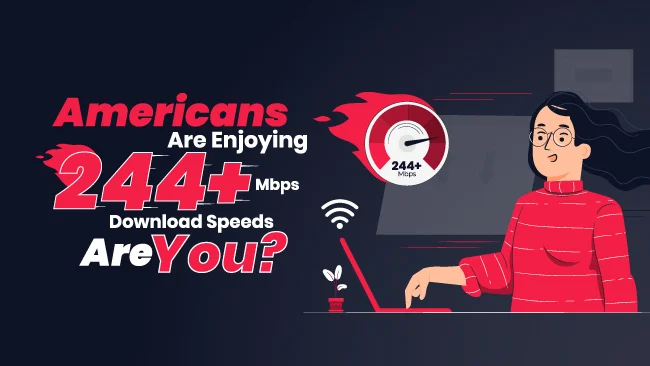Whats a good mbps download speed?
Whats a good Mbps download speed? Americans are speeding ahead of the world in the digital fast lane. The latest Speedtest.net report by Cables Finder shows that the US has impressive median fixed broadband speeds, with a download speed of 244.68 Mbps and an upload speed of 34 Mbps, ranking the US internet speed at 5th globally.
Americans are surfing the web with warp speeds as 9 in 10 households have access to at least 100 Mbps speeds which are generally considered Fast internet speeds that quickly transmit data without interruptions enabling smooth and efficient online activities
With nearly half of Americans (40%) now having access to the fastest mbps internet speeds above 1,000 Mbps, the expansion of fiber-optic infrastructure has raised the bar on whats a good Mbps download speed.
Fastest Internet Speed Provider
The latest Speedtest Global Index report reveals the fastest internet speed provider in the US. T-Mobile takes the crown for mobile internet, with speeds jumping from nearly 20 Mbps to 188 Mbps. For home internet, Cox leads the pack with blazing speeds of 261 Mbps, followed closely by Spectrum and AT&T Internet. Xfinity, Frontier, Optimum, and Verizon trail behind them in the league of fastest internet speed provider but still offer impressive speeds.
Fast internet is the one that keeps up with your pace. Mobile broadband is for internet on the go, while fixed broadband is for steady, fast, and affordable internet at home or office. Fixed broadband, like cable internet, is generally better for heavy use, while mobile broadband is ideal for quick tasks on your phone.
Internet Speed: How the U.S Stacks Up
The Internet Speed Gap
Although the US has made significant strides in internet speed over the past decade, whats a good download speed? The world's fastest internet speeds can be found in Singapore (285 Mbps), the United Arab Emirates (283 Mbps), Hong Kong (271 Mbps), and Chile (263 Mbps). Their compact size and targeted government investments have enabled these nations to surpass the US internet speeds.
The US faces challenges connecting rural areas due to its vast size. While 97% of the US is considered rural, only 16.7% of the population lives there, making infrastructure development costly.
The Price of Speed: U.S Internet Costs Compared
According to a study, US consumers pay an average of pay $68.38 per month for standalone internet which is more than those in Europe and Asia. Although the US offers fast internet speeds, but at higher delivery costs due to its large geographic area.
US prices are increasing and remain the highest among the countries studied but it does offer a unique advantage: low costs per megabit for heavy internet users.
The Uneven State of U.S Internet Access
The FCC’s 2023 data, 92.2% of US households have access to fast internet speeds of 100 Mbps or above. However, rural areas often rely on satellite internet, which can be costly and slow. New wireless fastest internet speed provider like T-Mobile and Verizon offer affordable alternatives like fixed wireless in some rural areas. Nevertheless, fiber internet access is mostly limited to urban areas, skewing national broadband averages. This means that not everyone benefits equally from the country's overall progress in broadband access.
The US still faces a significant gap in connectivity and speed with some individuals enjoying the fastest Mbps internet with download speeds of 1,000 Mbps, while others barely manage to access their email.
U.S Broadband: Progress and Potential
Despite the challenges the US faces with its broadband infrastructure, particularly in rural areas, recent data offers encouragement. A median speed of 244 Mbps is sufficient for most households, except for heavy users. The main issue is ensuring equal access to these speeds.
Fortunately, fiber and fixed wireless providers are experiencing growth, with fiber reaching the fastest Mbps internet speeds of 10 Gbps and beyond. Fixed wireless, meanwhile, offers speeds of 200-300 Mbps, suitable for smart homes with multiple users. These advancements indicate a promising future for US broadband connectivity.
Fiber internet installation is costly and complex, requiring extensive infrastructure, and navigating obstacles as well as environmental challenges making fiber optic installation a time-consuming and expensive project, hindering its widespread adoption.
Curious about your internet speed?
Test your internet speed now and compare it to the national average!

